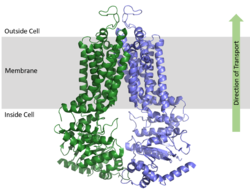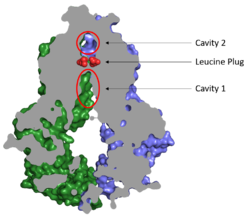Sandbox Reserved 1606
From Proteopedia
(Difference between revisions)
| Line 35: | Line 35: | ||
===Inhibitors=== | ===Inhibitors=== | ||
| - | The inhibition of ABCG2 would decrease the transport of anti-cancer drugs out of cancer cells and aid in the treatment of cancer. Due to the potential for ABCG2 inhibition to aid in cancer treatment, efforts have been made to develop specific inhibitors of ABCG2 and other ABC transporters. The ABC transporter ABCB1, also known as multidrug resistance 1 (MDR1), was a therapeutic target in previous studies which produced three generations of MDR1 inhibitors, such as [https://en.wikipedia.org/wiki/Verapamil verapamil], [https://en.wikipedia.org/wiki/Valspodar valspodar], and [https://en.wikipedia.org/wiki/Zosuquidar zosuquidar]; however, many of these inhibitors had neurotoxic effects that discouraged their use as anticancer drugs.<ref name="Leonard"/><ref name="Binkhathlan"/><ref name="Witherspoon | + | ABCG2 hinders cancer treatment by contributing to [https://en.wikipedia.org/wiki/Multiple_drug_resistance multidrug resistance] in tumor cells. ABCG2 exports xenbiotics, including vital anti-cancer drugs, which results in the inability to treat cancer cells. The inhibition of ABCG2 would decrease the transport of anti-cancer drugs out of cancer cells and aid in the treatment of cancer. Due to the potential for ABCG2 inhibition to aid in cancer treatment, efforts have been made to develop specific inhibitors of ABCG2 and other ABC transporters. The ABC transporter ABCB1, also known as multidrug resistance 1 (MDR1), was a therapeutic target in previous studies which produced three generations of MDR1 inhibitors, such as [https://en.wikipedia.org/wiki/Verapamil verapamil], [https://en.wikipedia.org/wiki/Valspodar valspodar], and [https://en.wikipedia.org/wiki/Zosuquidar zosuquidar]; however, many of these inhibitors had neurotoxic effects that discouraged their use as anticancer drugs.<ref name="Leonard"/><ref name="Binkhathlan"/><ref name="Witherspoon"/> |
| - | + | ||
| - | + | ||
ABCG2 <scene name='83/832932/Inhibitor_bound_cavity_1/1'>inhibitors</scene> that bind Cavity 1, acting as competitive inhibitors against ABCG2 substrates. Depending on the size of the inhibitor, one or two molecules can accommodate binding to the cavity and form <scene name='83/832932/Inhibitor_intxns_cavity1/1'>hydrogen bonds, van der Waals, and stacking interactions</scene> within the binding site.<ref name="Jackson"/> Many inhibitors are too big to be transported via the leucine plug resulting in the "clogging" of the transporter. With inhibitors acting as wedges, ABCG2 is locked in the inward-facing conformation and unable to transport molecules out of the cell.<ref name="Manolaridis"/> | ABCG2 <scene name='83/832932/Inhibitor_bound_cavity_1/1'>inhibitors</scene> that bind Cavity 1, acting as competitive inhibitors against ABCG2 substrates. Depending on the size of the inhibitor, one or two molecules can accommodate binding to the cavity and form <scene name='83/832932/Inhibitor_intxns_cavity1/1'>hydrogen bonds, van der Waals, and stacking interactions</scene> within the binding site.<ref name="Jackson"/> Many inhibitors are too big to be transported via the leucine plug resulting in the "clogging" of the transporter. With inhibitors acting as wedges, ABCG2 is locked in the inward-facing conformation and unable to transport molecules out of the cell.<ref name="Manolaridis"/> | ||
Revision as of 01:55, 18 April 2020
| This Sandbox is Reserved from Jan 13 through September 1, 2020 for use in the course CH462 Biochemistry II taught by R. Jeremy Johnson at the Butler University, Indianapolis, USA. This reservation includes Sandbox Reserved 1598 through Sandbox Reserved 1627. |
To get started:
More help: Help:Editing |
ABCG2 Multidrug Transporter
References
[1] [2] [3] [4] [5] [6] [7] [8] [9] [10] [11]
- ↑ 1.0 1.1 1.2 1.3 1.4 Taylor NMI, Manolaridis I, Jackson SM, Kowal J, Stahlberg H, Locher KP. Structure of the human multidrug transporter ABCG2. Nature. 2017 Jun 22;546(7659):504-509. doi: 10.1038/nature22345. Epub 2017 May, 29. PMID:28554189 doi:http://dx.doi.org/10.1038/nature22345
- ↑ 2.0 2.1 2.2 2.3 2.4 2.5 2.6 Manolaridis I, Jackson SM, Taylor NMI, Kowal J, Stahlberg H, Locher KP. Cryo-EM structures of a human ABCG2 mutant trapped in ATP-bound and substrate-bound states. Nature. 2018 Nov;563(7731):426-430. doi: 10.1038/s41586-018-0680-3. Epub 2018 Nov, 7. PMID:30405239 doi:http://dx.doi.org/10.1038/s41586-018-0680-3
- ↑ 3.0 3.1 Robey RW, Pluchino KM, Hall MD, Fojo AT, Bates SE, Gottesman MM. Revisiting the role of ABC transporters in multidrug-resistant cancer. Nat Rev Cancer. 2018 Jul;18(7):452-464. doi: 10.1038/s41568-018-0005-8. PMID:29643473 doi:http://dx.doi.org/10.1038/s41568-018-0005-8
- ↑ 4.0 4.1 4.2 Jackson SM, Manolaridis I, Kowal J, Zechner M, Taylor NMI, Bause M, Bauer S, Bartholomaeus R, Bernhardt G, Koenig B, Buschauer A, Stahlberg H, Altmann KH, Locher KP. Structural basis of small-molecule inhibition of human multidrug transporter ABCG2. Nat Struct Mol Biol. 2018 Apr;25(4):333-340. doi: 10.1038/s41594-018-0049-1. Epub, 2018 Apr 2. PMID:29610494 doi:http://dx.doi.org/10.1038/s41594-018-0049-1
- ↑ 5.0 5.1 Marzac C, Garrido E, Tang R, Fava F, Hirsch P, De Benedictis C, Corre E, Lapusan S, Lallemand JY, Marie JP, Jacquet E, Legrand O. ATP Binding Cassette transporters associated with chemoresistance: transcriptional profiling in extreme cohorts and their prognostic impact in a cohort of 281 acute myeloid leukemia patients. Haematologica. 2011 Sep;96(9):1293-301. doi: 10.3324/haematol.2010.031823. Epub, 2011 May 23. PMID:21606172 doi:http://dx.doi.org/10.3324/haematol.2010.031823
- ↑ 6.0 6.1 Bartholomae S, Gruhn B, Debatin KM, Zimmermann M, Creutzig U, Reinhardt D, Steinbach D. Coexpression of Multiple ABC-Transporters is Strongly Associated with Treatment Response in Childhood Acute Myeloid Leukemia. Pediatr Blood Cancer. 2016 Feb;63(2):242-7. doi: 10.1002/pbc.25785. Epub 2015 Oct, 29. PMID:26512967 doi:http://dx.doi.org/10.1002/pbc.25785
- ↑ 7.0 7.1 Mohelnikova-Duchonova B, Brynychova V, Oliverius M, Honsova E, Kala Z, Muckova K, Soucek P. Differences in transcript levels of ABC transporters between pancreatic adenocarcinoma and nonneoplastic tissues. Pancreas. 2013 May;42(4):707-16. doi: 10.1097/MPA.0b013e318279b861. PMID:23462326 doi:http://dx.doi.org/10.1097/MPA.0b013e318279b861
- ↑ 8.0 8.1 Mao Q, Unadkat JD. Role of the breast cancer resistance protein (BCRP/ABCG2) in drug transport--an update. AAPS J. 2015 Jan;17(1):65-82. doi: 10.1208/s12248-014-9668-6. Epub 2014 Sep 19. PMID:25236865 doi:http://dx.doi.org/10.1208/s12248-014-9668-6
- ↑ 9.0 9.1 Leonard GD, Fojo T, Bates SE. The role of ABC transporters in clinical practice. Oncologist. 2003;8(5):411-24. doi: 10.1634/theoncologist.8-5-411. PMID:14530494 doi:http://dx.doi.org/10.1634/theoncologist.8-5-411
- ↑ 10.0 10.1 Binkhathlan Z, Lavasanifar A. P-glycoprotein inhibition as a therapeutic approach for overcoming multidrug resistance in cancer: current status and future perspectives. Curr Cancer Drug Targets. 2013 Mar;13(3):326-46. doi:, 10.2174/15680096113139990076. PMID:23369096 doi:http://dx.doi.org/10.2174/15680096113139990076
- ↑ 11.0 11.1 Witherspoon SM, Emerson DL, Kerr BM, Lloyd TL, Dalton WS, Wissel PS. Flow cytometric assay of modulation of P-glycoprotein function in whole blood by the multidrug resistance inhibitor GG918. Clin Cancer Res. 1996 Jan;2(1):7-12. PMID:9816083
Student Contributors
Julia Pomeroy


